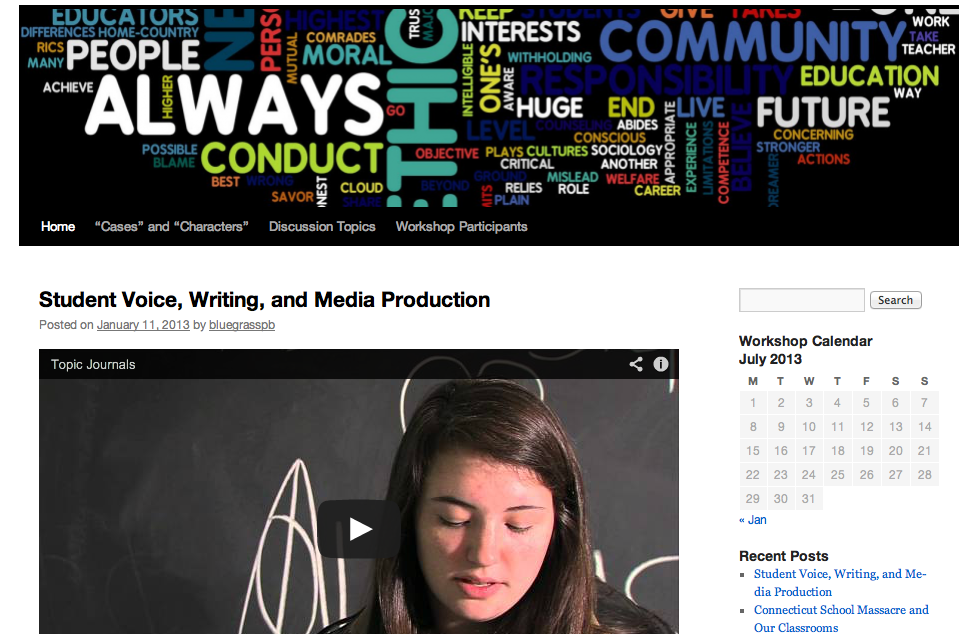Ethics and the Teaching of English
0September 5, 2013 by Tom McKenna

 by Dr. Jim Sabin
Dr. Sabin is a Clinical Professor of both Population Medicine and Psychiatry at Harvard Medical School and Director of the Harvard Pilgrim Health Care Ethics Program
by Dr. Jim Sabin
Dr. Sabin is a Clinical Professor of both Population Medicine and Psychiatry at Harvard Medical School and Director of the Harvard Pilgrim Health Care Ethics Program
In the years that I’ve been a faculty spouse since my wife Margery began teaching at the Vermont campus in 1992, I’d been making connections between my experience teaching medical ethics at Harvard Medical School, and the high school and middle school classroom experiences I heard about from students on the mountain. So when a change in the schedule in 2012 allowed for Friday workshops, I volunteered to do one on “integrating ethics into high school and middle school English class.”
BLTN sessions I’d attended had conveyed just how powerfully students are engaged by ethical issues—in their personal lives, communities, the literature they read, and the wider world. I hoped that the workshop would allow us to find ways that a medical school ethics teacher and high school/middle school English teachers could learn from each other in useful ways. I wasn’t disappointed!
What first led me to think of connecting medical school ethics to English class was recognition that my goals for medical students in the medical ethics course could be relevant for high school and middle school students as well:
- Strengthen “moral imagination”—the ability to identify ethical issues
- Develop systematic approaches to resolving ethical questions—approaches, not answers
- Increase skills for dealing with “good v good” conflicts, for tolerating uncertainty and ambiguity, and for responding respectfully to people and positions we disagree with
- Cultivate the habit of using personal reactions as “data,” not necessarily as “truth.” This doesn’t come naturally to most adults, and is even more challenging for adolescents
- Enhance capacity to reason to a justifiable conclusion and articulate our rationale.
In the workshop we identified two components of ethics:
● Ethical analysis = deliberating about the right thing to do or the right way to be
● Ethical activism = putting values into action/persuading others
Medical school ethics courses focus on ethical analysis, since the students have not yet begun to work on hospital wards and in outpatient clinics, where values are put into action. It has been well documented that experience with harried physician-teachers in the rushed atmosphere of hospital rotations often results, alas, in negative socialization and a diminution of the idealism that students start with. (In the Harvard Medical School ethics course, we devote a two-hour session to developing strategies to ward off the potential for dehumanization.) But at the BLTN and Andover Bread Loaf presentations, I heard about many projects that combined analysis and activism, and that these projects engaged students deeply.
In the July, 2012 workshop we addressed three topics brought forward by the participants:
Literature and ethics. Students typically respond to characters and situations in literature in moral terms—they approve or disapprove of a character or about the right way to respond to a situation. One participant told us that whenever he’s teaching literature he feels that he’s teaching ethics at the same time. Others agreed, and described the teaching goal as connecting the student’s moral reactions to deeper engagement with the text. Does the text support the student’s perspective? Is the text asking students to question their presuppositions? One teacher reported that when her class read fairy tales, she asked the students to write from the perspective of different characters. When students took on the role of the “villain,” they realized that from within villains do not see themselves as villainous.
Digital ethics. Several teachers had experimented with digital media. Students have grown up in a digital world, and many topics that might fall flat in a purely verbal format were more engaging when developed with digital technologies. The technologies themselves raised important ethical questions: defining the difference between research and plagiarism; understanding the implications of how we present ourselves on social media; confronting bullying behaviors; and more.
Classroom management and discipline. In medical school teaching, classroom management is a relatively minor challenge. It’s much more important in high school and middle school and typically learned on the job, with varying degrees of success. Workshop participants saw classroom management and discipline as areas where articulation of the underlying rationale gave educational opportunity, and where the teacher-role gave opportunity for modeling values of tolerance, fairness and respect.
Participants in the July 2012 workshop found tremendous value in serious conversation about topics they’d thought about on their own and exchange of practical tips with colleagues. That’s what led to the idea of following up the two-hour workshop with an online venture.
We began the BLTN online workshop with an extended exchange about digital ethics. At the conclusion, a participant suggested that we “find a way to conduct research on the ideas we are sharing as to track and show student learning.” This suggestion for collaborative research will be an organizing principle for the forthcoming 2013-2014 online activity.
To plan this activity, twelve Bread Loaf students and three faculty members participated in a second Vermont campus workshop this summer. As an initial topic, several participants posed questions about whether and how to use their own experience, beliefs, or values in class discussion. (In the medical world this is called “self disclosure.” A short piece on the topic that I wrote for medical students and residents is here.)
A participant told the workshop group that when a class was discussing Shakespeare’s sonnets, a boy said, “There’s no such thing as bisexuality.” The participant told the workshop “I’m bisexual, and when the boy said, ‘There’s no such thing as bisexuality,’ I asked myself if I should disclose that in response to the student’s comment.” The participant decided not to make a personal disclosure. It would have come out of the blue for the students, and making a personal response was not necessary, since Shakespeare’s own writing was available to make the point that there is indeed such a thing as bisexuality! By contrast, the workshop group was composed of peer teachers with whom the participant felt comfortable, and the disclosure was in service of collaborative discussion of a teaching dilemma.
Our discussion touched on the potential importance of “role modeling” as an educational force in character development. Albert Schweitzer had a very strong view about this question: “Example is not the main thing in influencing others. It is the only thing.” Participants who taught at boarding schools reported that they are on near-constant display to their students. For them the question of role modeling isn’t optional. But every classroom teacher has the opportunity to model democratic values of curiosity, respect, and enthusiasm for learning.
As a second topic, we discussed how to best respond when students are wrong without intimidating them or squelching their curiosity. If a student says the equivalent of “9 plus 2 equals 10,” he’s just plain wrong. But might there be learning potential in the error? The workshop group thought there was. How did the student get to the wrong answer? Exploration was seen as a key pedagogical strategy embodying the values of respect and curiosity. It’s hard for students to become creative if they can’t tolerate being wrong! One participant described encouraging students to take chances in their writing—“the riskier the better!” Others described efforts to make the class environment itself into what some students call a “safe space” within which disagreement and being wrong can be seen as valuable learning opportunities, not intimidating stressors.
Even for perspectives that the teacher finds deeply objectionable, such as sexist or homophobic comments, developing a fuller understanding of what students mean and where they “are coming from” was seen as the right start. The “I have a friend” technique can be useful—invoking someone other than the teacher as the vehicle for a communication. And taking the “devil’s advocate” stance can allow the teacher to take a position but in the role of “devil” rather than that of “authority.” Response from peers, when it occurs, can be a very powerful form of education. As an example, a participant described a class discussion in which after one student made a strongly homophobic statement, another replied that a close family member was gay and he was offended by the comment.
The overarching conclusion from the two summer workshops and the online BLTN project was that using the framework of ethics education for extended, in-depth discussion of teaching strategies was stimulating, valuable, and fun. Exploring the complexities of the classroom was very productive, and sharing experiences enhanced a sense of solidarity. Crossing boundaries between medical school, high school, and middle school classrooms took the discussion to a deeper level.
The 2013-2014 online BLTN workshop will be organized around collaborative research on two large topics: classroom approaches to (a) ethics and literature and (b) digital ethics. If you would like to participate or have suggestions, please send them to me at JimSabin@gmail.com.
Category Faculty Notes, Fall 2013, Issue | Tags:
Leave a Reply